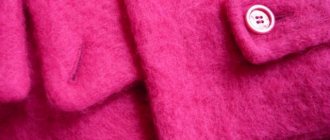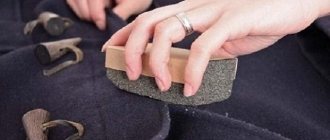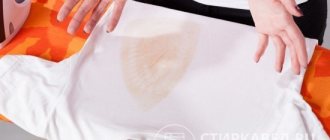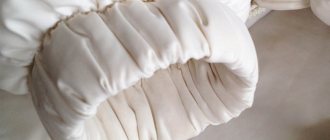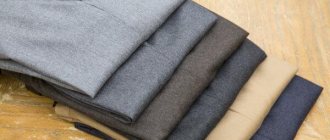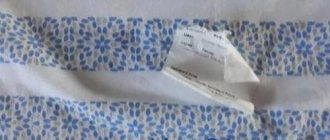A new item looks perfect, but after washing everything can change. Rolled fibers will appear on the fabric, which will ruin the appearance of the product and the mood of the owner.
Pellets are not always a sign of a low-quality product; the reason may be due to improper care and use. You can fix the problem if you have patience and take the advice of experienced housewives.
We'll tell you in this article how to remove pellets from bed linen, socks, sweatshirts and other things, and the ceiling in a car.
Electric razor and hair clipper
In the struggle to maintain a neat appearance of clothing, men's electric shavers and hair clippers are sometimes quite successfully used.
An electric razor, in fact, repeats the work of a machine to trim pellets, except that it is designed for a more delicate and fine texture.
The clipper will remove excess hair in head shaving mode. It’s important to adapt here and not make holes.
Read also: WHY DO YOUR FINGERS GO NUMBER
- Pros: high speed; removes pellets well.
- Cons: frequent “haircuts” will dull the blades, and this is already quite an expensive pleasure.
Last resort - dry cleaning
The most effective and efficient way to quickly and efficiently remove small balls. Of course, it is irrational to hand over everyday pants or a jacket, since dry cleaning services require significant financial costs. But it is best to entrust an expensive coat or blouse to specialists.
At the dry cleaners, they will not only remove knots from the item, but also wash and iron it at the client’s request. Here, clothes can be treated with special solutions that prevent the appearance of glomeruli. The procedure ensures the durability of the product.
Do not forget that it is best to use the services of a trusted organization with a good reputation.
How to remove pellets without ruining the item?
- Machine to remove the pellets The device with which it is simplest and easiest to cope with this problem. Operating principle: neatly cutting pellets from fabric. The device is recommended for knitwear and any woolen fabrics.
In particular, for angora and mohair. Advantages of the machine: the ability to adjust the height of the knife (so as not to damage the decorations on clothes), a container for pellets, quick and easy removal of pellets (price - 200-400 rubles). - Razor The method is very fast, radical and dangerous for the fabric. By securing the blade in a safety razor (Soviet style), you can easily remove pellets from knitwear. But you should approach the processing of woolen items with caution: take a not new razor, stretch the fabric as much as possible, carefully cut off the pellets, guiding the blade along the surface of the fabric from bottom to top. The method is ideal for “shaving” hats, socks and tights (the latter are easiest to process by pulling them over your legs), for fabrics without a relief pattern (smooth). But it is not recommended to shave items made from angora, mohair and cashmere.
- Scotch You can’t expect a 100% result (although it depends on the type of fabric), so we choose the adhesive tape (plasters, adhesive tape) that is as sticky as possible.
The principle of operation is the same as with wax strips for hair removal: put the strip on, press it, and sharply tear it off. The method is suitable for those things where pellets have just begun to appear. - Scissors Slow, tedious and labor-intensive method. The pellets should be carefully cut off one at a time. True, there is a danger of permanent tissue damage. You can simplify the task by first combing the item with a fine-toothed comb.
- Dry cleaning An excellent option for those who don’t have the wind whistling in their wallet. The dry cleaning staff will wash, clean, iron, and remove pellets from your favorite item.
- Toothbrush A good way to combat pellets on fabrics prohibited for shaving (mohair, angora, etc.). Choose a soft toothbrush, guide it along the fibers (otherwise your favorite sweater will simply be ruined) and comb the item until the pellets are completely removed. After combing out the pellets, soak the item in a bowl of warm water and vinegar to add fluffiness. And you should dry it by placing the item on a dry towel and away from the sun and heaters.
- Roller with adhesive tape Suitable for almost any thing, but, again, as in the case of adhesive tape, only for a small number of barely visible pellets.
Lifehack 4 - old men's razor
This method is ancient, almost everyone knows about it. Suitable for caring for smooth items, especially socks, knitted tights, hats. Where the knitted fabric is smooth, without patterns. In this case, it is best to use an old razor that is already slightly dull. A new one can easily cut the product.
How to remove pills from clothes at home using a razor:
- Stretch and secure the wool fabric so that you can handle it comfortably. Moreover, you should not stretch it too much - this can cause the clothes to stretch and lose their shape.
- Lean the razor against the surface of the fabric, without pressing it, but as if from above, cut off the pellets from the clothing. Run the razor from bottom to top across the clothing to catch as many pellets as possible.
- In this way, clean all the places on the sweater where pills have formed.
How to remove pills from clothes with a razor
Important:
This is a rather aggressive way to remove pellets from clothes; there is a high probability of cutting the fabric. Not suitable for caring for angora, cashmere, and mohair.
Machine or blade
Shaving clothes with disposable machines is a working method that many people use very often. This should be done on a flat, hard surface, running the razor along the hair growth line.
There are aces who use ordinary steel razor blades or stationery knives for this procedure. Here you need, of course, to have a certain skill. In both cases, there is a high risk of damaging both the hands and the fabric, and the threads themselves may become thinner from exposure to the cutting edge.
Read also: Pain in the arms, causes and treatment
- Pros: high speed; removes pellets well.
- Cons: there is a high probability of cutting yourself and ruining the thing.
Are all methods for removing lumps from clothes really effective?
There are a lot of tips on the Internet on how to get rid of pilling on a sweater, dress and trousers. Some methods are ineffective: the use of inappropriate products does not bring any benefit or leads to damage to the item, the appearance of small holes or stains.
Questionable methods for removing pellets:
- sandpaper, a dry piece of black bread, pumice, a coarse washcloth. If you rub the surface of the product with objects with a hard surface, it is easy to damage the material. Treatment with pumice and sandpaper can hopelessly ruin your favorite item;
- blade and scissors. Cutting the pellets is very difficult: filigree precision is required to remove the ball of hair without cutting a hole. Large spools on knitted items have a “leg” made of the main threads of the fabric. If scissors or a blade passes through this area, then the appearance of a hole is inevitable;
- scotch. The sticky surface collects only “fresh”, small pellets and only from dense, smooth surfaces;
- clothes or toothbrush. A well-advertised but ineffective method. It is very difficult to clean a jacket or sweater from hairballs; the pellets move left and right, some lag behind the surface, but most of the matted clumps remain in place. Active friction can lead to the appearance of new lumps on knitwear and woolen items.
Why do pills appear on clothes?
When you wear clothes, wash them, or throw a backpack strap over your shoulder, small lumps of tangled fibers appear on things due to friction.
The longer the pile and the lower the density of the fabric, the more pilling there will be. The most problematic in this regard are wool (especially large knits), flannel and almost any low-quality fabric. It is impossible to avoid the appearance of pellets, but it is quite possible to remove them. Clothes will look much neater after such cleaning. We have selected the simplest and most effective home methods. But if you don’t want to take care of your clothes yourself, then you can turn to professionals. A good dry cleaner will not only wash the item, but also remove the pellets.
How to delete
There are many ways to deal with unevenness in the tissue structure. They are similar in principle of operation, since they are based on mechanical cleaning. Try cleaning a small, inconspicuous area of fabric. If the method works, then continue cleaning further.
Special machine
In fabric stores, purchase a useful small accessory - a fabric machine. At first glance, the device looks like an old razor. There are blades inside the grooves - they cut off the resulting fluff on the canvas. The operating principle of the device is as follows:
- connect the device to the network;
- lay the product on the table;
- run the device over the fabric, paying special attention to areas where unevenness and fluff accumulate. There is no need to press on the material.
The device is convenient to use for cleaning knitted sweaters, corduroy pants, and coats. An old sweater will become like new in just a couple of minutes of machine operation. The device has a special compartment that stores the resulting debris. The device will last a long time and will help in preserving things.
On a note!
The price of the device is 150-400 rubles.
Brush
Another household appliance that can restore fabric to its original appearance is called a pellet brush. You will find it in home products. A brush differs from a machine in that it looks like a razor. It has a long handle that makes it easy to grasp the device. How to remove pills from a sweater is described below:
- place the jacket on a flat surface;
- brush over the fabric, holding the product;
- brush off the pellets and continue to brush the sweater until it becomes smooth.
After use, rinse the brush with water to remove any remaining cut fluff, then it will last a long time.
Razor
In order not to spend money on purchasing a device, we remove pills from clothes using a conventional machine. Take a new disposable razor, the more blades it has, the better. Stretch the fabric and move the loom from bottom to top, without pressing on it or rushing. The new razor removes balls well, the material immediately takes on a neat appearance. Be careful, the fabric can be easily cut if you move the razor very quickly. Do not take an old machine; its blades are already dull and will not help in cleaning.
Scotch
How to get rid of pellets without a machine and without machines? Of course, with tape. If the fabric began to deteriorate relatively recently, then this method will be very effective. Place strips of any adhesive tape on the rolled area and tear them off sharply. Press the adhesive tape onto the fabric with force, then cleaning will happen better and faster.
Attention!
After applying the tape, wash the item with soap to remove any remaining adhesive.
Scissors
Not the fastest, but most effective method of dealing with imperfections on fabric are ordinary scissors. If you have free time, trim off all the imperfections from the fabric surface, moving from bottom to top. The haircut works well when the balls are large and visible on the fabric. For small rolled areas, scissors are powerless.
Toothbrush
The following method will tell you how to remove pellets from a coat. You will need an old toothbrush for this. Straighten the coat from creases and “comb” the fibers of the fabric with a brush. Move along the fibers, collecting the pellets in one pile, this makes them easier to remove. To add shine to the pile, soak a clean cloth in water and vinegar (1 tablespoon per 5 liters of water). A damp cloth will collect the remaining fabric, and the coat will gain shine and an attractive appearance.
Adhesive tape roller
As soon as the first pellets appear, a roller with adhesive tape will help. Run the sticky side of the roller 4-5 times in a row over your favorite blouse; the adhesive base will collect pellets and fluffy lumps. This method is more likely to prevent the formation of balls; a roller obviously will not save a heavily rolled fabric.
Comb
Comb delicate, long-pile fibers with a regular fine-tooth comb. When combing, the teeth capture and tear off large pellets without causing damage to the fabric. The denser the teeth on the comb, the more effective the cleaning will be.
Important!
Hold woolen clothing while brushing, otherwise the teeth will leave lingering marks on the item.
Dry cleaning
If you are still afraid of damaging the item, or the product is expensive, do not take risks. Take your clothes to a dry cleaner, they will solve the problem in a few hours. Dry cleaning employs highly qualified personnel who encounter similar situations every day. They have modern equipment and special cleaning technologies. Getting rid of pellets in this way is not cheap, but the product will definitely be saved.
Bread crumbs
An alternative to household appliances and razors is a regular dried piece of bread. Bread crumbs pick up imperfections and imperfections on the fabric surface. You can use this property and do the following:
- dry a couple of pieces of bread;
- run a crouton over the rolled-up clothes several times in one direction;
- collect the remaining crumbs with your hand;
- wash the product in soapy water.
Attention!
You need to use varieties of black bread, they do not leave greasy stains.
Sandpaper
Use a radical method - clean your clothes with a piece of sandpaper. The method is risky, as it can cause damage to the material, for example, tearing or leaving puffs. If you do the procedure carefully, then no trouble will happen. Take a sheet of new fine-grit sandpaper and rub it over the item from bottom to top. If the result does not appear, do it again, but with a little more effort. The sandpaper will remove the top fluffy layer from the product, and it will become as good as new.
Sponge for washing dishes
The sponge always has a hard side, which is useful for getting rid of hated balls. Do not wet the product before cleaning, otherwise the foam will soften. Using a dry sponge (hard side), lightly rub it in a circular motion over the rolled-up item. The pellets will collect into large balls, which can then be easily removed. A sponge will help clean even delicate items or products where the fabric is very thin.
Features of caring for knitted woolen items
It is better to wear elegant knitted items without outerwear when weather conditions permit. But in cases where pellets appear regularly, you need to choose the most suitable cleaning method for this type of knitwear.
- These may include: cutting off large formations with scissors, combing with a fine, hard brush, or processing with a special machine.
- Rinse gel additives can eliminate pilling from clothes over several washes.
For clothes that are made by hand or have a complex openwork structure, when machine washing, you can use a bag in which it will spin in the drum, protected by thick fabric.
Trade secrets
There are ways to reduce the ability of any fabrics and fabrics to form pills. Unfortunately, whether the fabric has undergone special processing or not, the average consumer will hardly be able to find out how high-quality fibers were used in the production of the fabric.
Pillability is affected by fiber composition, thread structure, fabric structure and finishing. The less return (waste) was used in production, the lower the pillability. The use of longer fibers, thinning of the cross section, increasing the twist of threads and reducing the length of overlap in the fabric, reducing the length of the loop and the use of special chemical impregnations also leads to a decrease in pillability. They use singeing, cutting products, and heat setting.
Legend for fabric composition:
| Main reduction | in Russian | in English |
| WO | wool | Wool Woole |
| W.P. | alpaca | Alpaca Alpaca |
| W.L. | lama | Lame Lame |
| W.K. | camel's wool | Camel Kamel |
| W.S. | Kashmir | Cashmere Kaschmire |
| W.M. | moxep | Mohair Mohair |
| W.A. | angora | Angora Angora |
| W.G. | vigunya | Vicuna Vikunja |
| Wu | guanoco | Guanaco Guanaco |
| S.E. | silk | Silk Seide |
| CO | cotton | Cotton Baumwoole |
| Li | linen | Linen Linane |
| J.U. | jute | Jute Jute |
| AB | abacus | Abace Manila |
| KE | kenaf | Kenaf Kenaf |
| R.A. | ramie | Ramie Ramie |
| Si | sisal | Sisal Sisal |
| A.C. | acetate fiber | Acetate |
| C.U. | copper-ammonia fiber | Cupro |
| MD | modal | Modal Modal |
| T.A. | triacetate | Triacetate |
| Vi | viscose | Viscose (rayon) Viskose |
| PC | nitrone (PAN) | Acrylic Polyacryl |
| M.A. | modified PAN (modacryl) | ModacrylicModacryl |
| PA | polyamide (nylon) | Nylon Polyamide |
| P.L. | polyester (polyester, lavsan) | Polyester |
| P.E. | polyethylene | Polyethylene Polyathylene |
| PP | polypropylene | Polypropylene Polypropylene |
| P.U. | polyurethane | Polyurethane Polyurethane |
| E.A. | elastane | Elastane Elasthan |
| A.F. | other fibers | Other fibers Sostige fasern |
Luxury clothes and pellets
Oddly enough, men are luckier in this matter than women. By buying a super wool suit, a 100% cotton pique polo and chino trousers, they can be 99% sure that the pilling problem will not affect them. And with knitwear in the luxury segment, as well as in the middle segment, everything is fine.
In women's luxury wardrobe there are more items of clothing that say 100% polyester. Cocktail and evening dresses, lingerie, and beachwear are almost 100% made from synthetic fibers. Is it another synthetic? I want to believe it, because you can only check it while wearing it. In my experience and the experience of my clients, synthetic clothes, even branded ones, are still susceptible to pilling.
Garment care and pilling
It is important to remember that care does not affect the formation of pellets. Improper care can ruin a thing (it can shrink, fade, become deformed, etc.), but improper care cannot cause the formation of pili!
Buy wisely, ultimately the choice is yours! Share your experience!
Reasons for appearance
More often, pellets appear on soft, loose fabrics with pile or admixtures of polyester, acrylic or nylon fibers. They are located in places of constant friction or interaction with foreign objects. For example, a bag or a backpack.
The reasons may be:
Incorrect care . The washing program, temperature and detergent do not match the type of fabric.- Mixed composition of the material . Susceptible to rolling in tandem synthetic and natural fibers.
- Density and structure of fabric . Threads of medium and weak twist, weak weaving, as a result - a loose fabric that quickly loses its appearance.
Before blaming the manufacturer, carefully study the composition and recommendations on the product label. It will help you find the cause of the problem.
